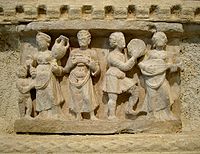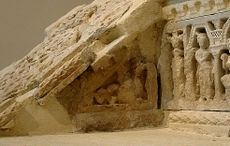
Kanishka I, Kanishka or Kanishka the Great, was an emperor of the Kushan dynasty, under whose reign the empire reached its zenith. He is famous for his military, political, and spiritual achievements. A descendant of Kujula Kadphises, founder of the Kushan empire, Kanishka came to rule an empire extending from Central Asia and Gandhara to Pataliputra on the Gangetic plain. The main capital of his empire was located at Puruṣapura (Peshawar) in Gandhara, with another major capital at Mathura. Coins of Kanishka were found in Tripuri.
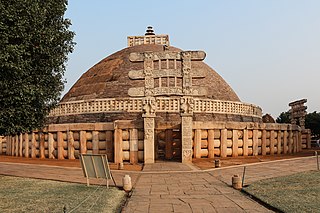
In Buddhism, a stupa is a mound-like or hemispherical structure containing relics that is used as a place of meditation.

The Greco-Buddhist art or Gandhara art is the artistic manifestation of Greco-Buddhism, a cultural syncretism between Ancient Greek art and Buddhism. It had mainly evolved in the ancient region of Gandhara, located in the northwestern fringe of the Indian subcontinent.

Sirkap is the name of an archaeological site on the bank opposite to the city of Taxila, Punjab, Pakistan.

Haḍḍa is a Greco-Buddhist archeological site located ten kilometers south of the city of Jalalabad, in the Nangarhar Province of eastern Afghanistan.

The Guimet Museum is an art museum located at 6, place d'Iéna in the 16th arrondissement of Paris, France. Literally translated into English, its full name is the National Museum of Asian Arts-Guimet, or Guimet National Museum of Asian Arts.

Buner reliefs is a term for a number of stone reliefs in or taken from Buner District, in the Peshawar valley in Pakistan, once in ancient Gandhara. They are also near the Swat Valley.
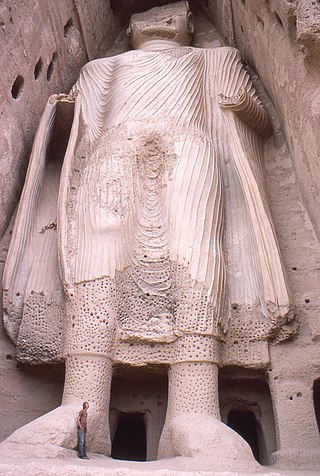
Buddhism, a religion founded by Gautama Buddha, first arrived in modern-day Afghanistan through the conquests of Ashoka, the third emperor of the Maurya Empire. Among the earliest notable sites of Buddhist influence in the country is a bilingual mountainside inscription in Greek and Aramaic that dates back to 260 BCE and was found on the rocky outcrop of Chil Zena near Kandahar.
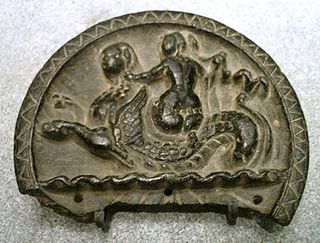
A stone palette is a round tray commonly found in the areas of Bactria and Gandhara, and which usually represent Greek mythological scenes. Some of them are attributed to the Indo-Greek period in the 2nd and 1st century BCE Many are considered to be of later production, around the 1st century CE during the time of the Indo-Parthians. They practically disappeared after the 1st century. Many have been found at the archaeological site of Sirkap, in today's Pakistan.

Indo-Corinthian capitals are capitals crowning columns or pilasters, which can be found in the northwestern Indian subcontinent, and usually combine Hellenistic and Indian elements. These capitals are typically dated to the first centuries of the Common Era, and constitute an important aspect of Greco-Buddhist art.

The Indo-Greeks practiced numerous religions during the time they ruled in the northwestern Indian subcontinent from the 2nd century BCE to the beginning of the 1st century CE. In addition to the worship of the Classical pantheon of the Greek deities found on their coins, the Indo-Greeks were involved with local faiths, particularly with Buddhism, but also with Hinduism and Zoroastrianism.

Indo-Greek art is the art of the Indo-Greeks, who reigned from circa 200 BCE in areas of Bactria and the Indian subcontinent. Initially, between 200 and 145 BCE, they remained in control of Bactria while occupying areas of Indian subcontinent, until Bactria was lost to invading nomads. After 145 BCE, Indo-Greek kings ruled exclusively in parts of ancient India, especially in Gandhara, in what is now present-day the northwestern Pakistan. The Indo-Greeks had a rich Hellenistic heritage and artistic proficiency as seen with the remains of the city of Ai-Khanoum, which was founded as a Greco-Bactrian city. In modern-day Pakistan, several Indo-Greeks cities are known such as Sirkap near Taxila, Barikot, and Sagala where some Indo-Greek artistic remains have been found, such as stone palettes. Some Buddhist cultural objects related to the Indo-Greeks are known, such as the Shinkot casket. By far the most important Indo-Greek remains found are numerous coins of the Indo-Greek kings, considered as some of the most artistically brilliant of Antiquity. Most of the works of art of the Greco-Buddhist art of Gandhara are usually attributed to the direct successors of the Indo-Greeks in Ancient India in the 1st century CE, such as the nomadic Indo-Scythians, the Indo-Parthians and, in an already decadent state, the Kushans. Many Gandharan works of art cannot be dated exactly, leaving the exact chronology open to interpretation. With the realization that the Indo-Greeks ruled in India until at least 10-20 CE with the reign of Strato II in the Punjab, the possibility of a direct connection between the Indo-Greeks and Greco-Buddhist art has been reaffirmed recently.

Buddhism has existed in Greece since antiquity. Today, there is a sizable Buddhist community in Greece, comprising immigrants and native Greek converts. Buddhism has influenced Greek literary tradition to some extent, as evident in the works of Nikos Kazantzakis.
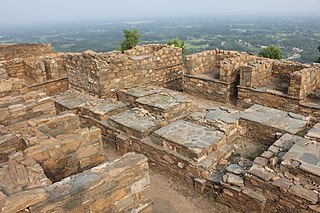
Jamal Garhi is a small town located 13 kilometers from Mardan at Katlang-Mardan road in Khyber Pakhtunkhwa province in northern Pakistan. Jamal Garhi was a Buddhist monastery from the first until the fifth century AD at a time when Buddhism flourished in this part of the Indian subcontinent. The monastery and main stupa are surrounded by chapels closely packed together. The site is called "The Jamal Garhi Kandarat or Kafiro Kote" by the locals.
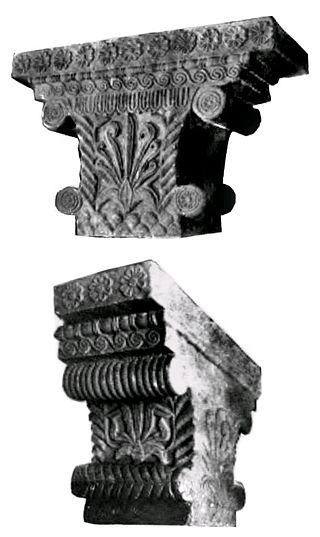
Hellenistic influence on Indian art and architecture reflects the artistic and architectural influence of the Greeks on Indian art following the conquests of Alexander the Great, from the end of the 4th century BCE to the first centuries of the common era. The Greeks in effect maintained a political presence at the doorstep, and sometimes within India, down to the 1st century CE with the Greco-Bactrian Kingdom and the Indo-Greek Kingdoms, with many noticeable influences on the arts of the Maurya Empire especially. Hellenistic influence on Indian art was also felt for several more centuries during the period of Greco-Buddhist art.

The Art of Mathura refers to a particular school of Indian art, almost entirely surviving in the form of sculpture, starting in the 2nd century BCE, which centered on the city of Mathura, in central northern India, during a period in which Buddhism, Jainism together with Hinduism flourished in India. Mathura "was the first artistic center to produce devotional icons for all the three faiths", and the pre-eminent center of religious artistic expression in India at least until the Gupta period, and was influential throughout the sub-continent.

The Stupa No. 2 at Sanchi, also called Sanchi II, is one of the oldest existing Buddhist stupas in India, and part of the Buddhist complex of Sanchi in Madhya Pradesh. It is of particular interest since it has the earliest known important displays of decorative reliefs in India, probably anterior to the reliefs at the Mahabodhi Temple in Bodh Gaya, or the reliefs of Bharhut. It displays what has been called "the oldest extensive stupa decoration in existence". Stupa II at Sanchi is therefore considered as the birthplace of Jataka illustrations.

Kushan art, the art of the Kushan Empire in northern India, flourished between the 1st and the 4th century CE. It blended the traditions of the Greco-Buddhist art of Gandhara, influenced by Hellenistic artistic canons, and the more Indian art of Mathura. Kushan art follows the Hellenistic art of the Greco-Bactrian Kingdom as well as Indo-Greek art which had been flourishing between the 3rd century BCE and 1st century CE in Bactria and northwestern India, and the succeeding Indo-Scythian art. Before invading northern and central India and establishing themselves as a full-fledged empire, the Kushans had migrated from northwestern China and occupied for more than a century these Central Asian lands, where they are thought to have assimilated remnants of Greek populations, Greek culture, and Greek art, as well as the languages and scripts which they used in their coins and inscriptions: Greek and Bactrian, which they used together with the Indian Brahmi script.
Garlands bearers, typically in the form of small naked putti holding up a continuous garland very large in relation to their size, formed a popular ornamental design in classical arts, from the Greco-Roman world to India, with ramifications as far as China. In Europe they were revived in the Renaissance, and continued in later periods.

Indo-Scythian art developed under the various dynasties of Indo-Scythian rulers in northwestern India, from the 1st century BCE to the early 5th century CE, encompassing the productions of the early Indo-Scythians, the Northern Satraps and the Western Satraps. It follows the development of Indo-Greek art in northwestern India. The Scythians in India were ultimately replaced by the Kushan Empire and the Gupta Empire, whose art form appear in Kushan art and Gupta art.






